Comprehensive Report: Human Reproduction, IVF, and Case Studies
VerifiedAdded on 2020/10/22
|7
|998
|125
Report
AI Summary
This report examines human reproduction, differentiating between sexual and asexual reproduction. It focuses on the male and female reproductive systems, detailing the process of in vitro fertilization (IVF) as a solution for infertility, particularly in cases of low sperm count. The report explains the IVF process, including suppressing the menstrual cycle, superovulation, egg retrieval, insemination, fertilization, embryo transfer, and the use of IVF for various conditions like fallopian tube damage, ovulation disorders, and genetic disorders. The report also presents the success rates of IVF based on age. A case study is included, highlighting how IVF can help couples with infertility issues. The report concludes with a summary of the findings and a list of references.
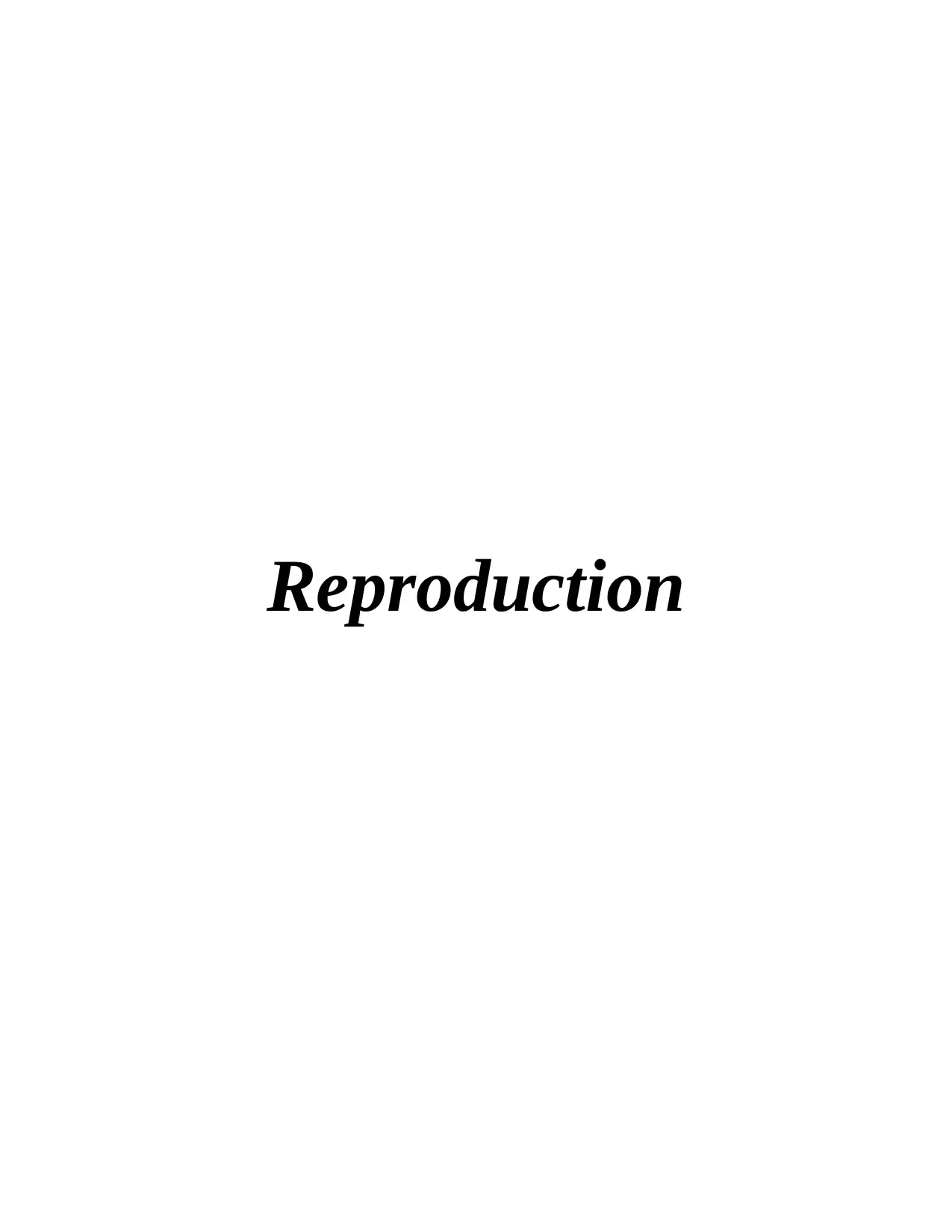
Reproduction
Paraphrase This Document
Need a fresh take? Get an instant paraphrase of this document with our AI Paraphraser
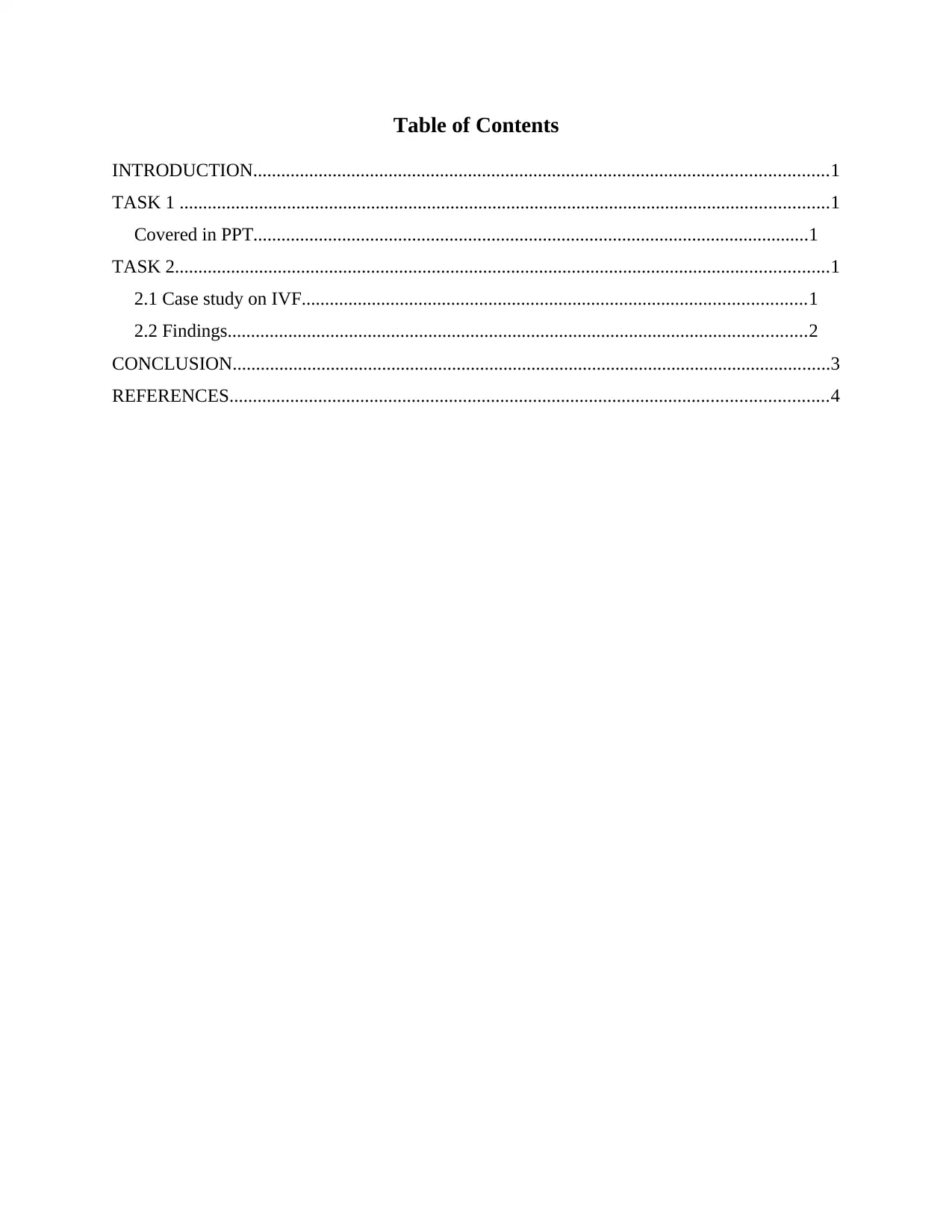
Table of Contents
INTRODUCTION...........................................................................................................................1
TASK 1 ...........................................................................................................................................1
Covered in PPT.......................................................................................................................1
TASK 2............................................................................................................................................1
2.1 Case study on IVF............................................................................................................1
2.2 Findings............................................................................................................................2
CONCLUSION................................................................................................................................3
REFERENCES................................................................................................................................4
INTRODUCTION...........................................................................................................................1
TASK 1 ...........................................................................................................................................1
Covered in PPT.......................................................................................................................1
TASK 2............................................................................................................................................1
2.1 Case study on IVF............................................................................................................1
2.2 Findings............................................................................................................................2
CONCLUSION................................................................................................................................3
REFERENCES................................................................................................................................4

⊘ This is a preview!⊘
Do you want full access?
Subscribe today to unlock all pages.

Trusted by 1+ million students worldwide
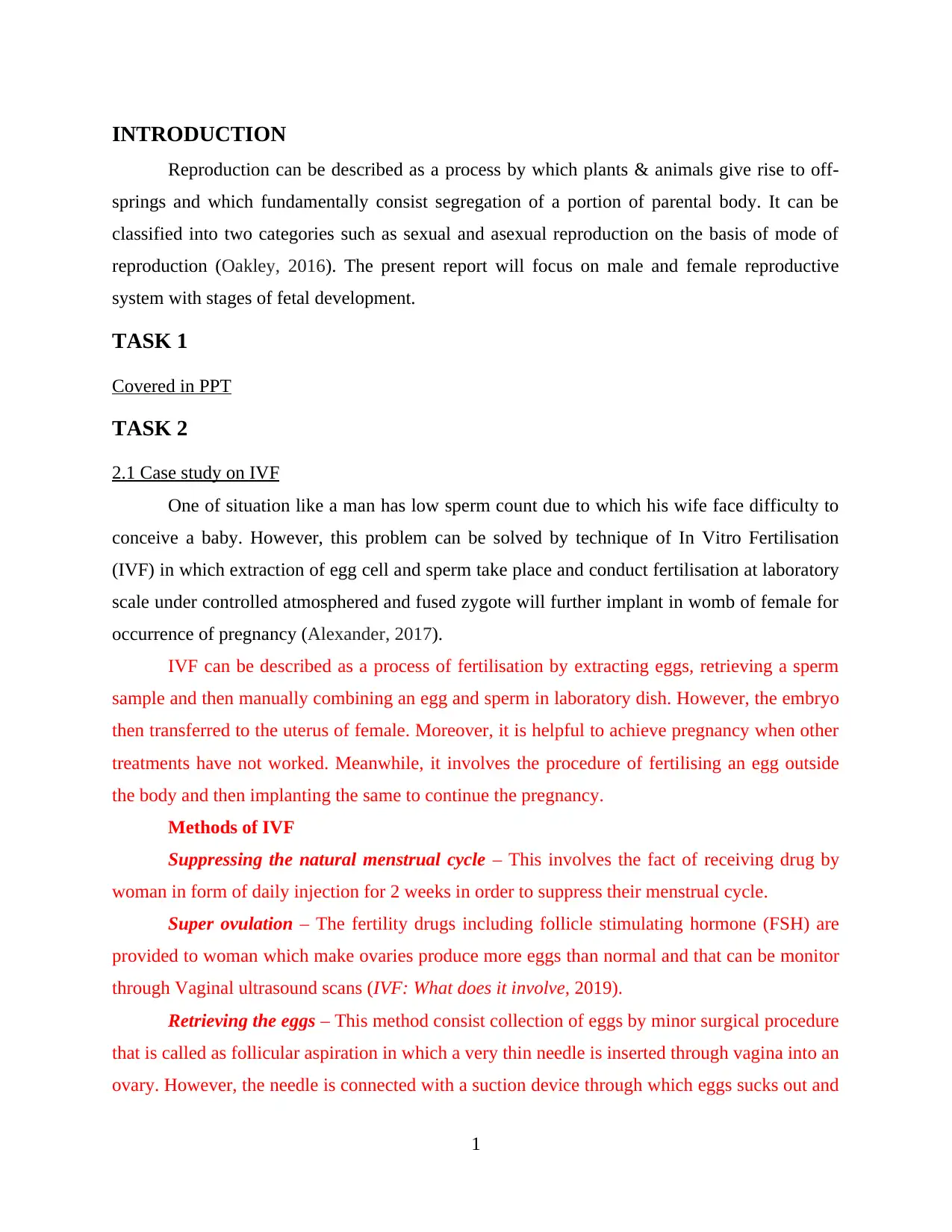
INTRODUCTION
Reproduction can be described as a process by which plants & animals give rise to off-
springs and which fundamentally consist segregation of a portion of parental body. It can be
classified into two categories such as sexual and asexual reproduction on the basis of mode of
reproduction (Oakley, 2016). The present report will focus on male and female reproductive
system with stages of fetal development.
TASK 1
Covered in PPT
TASK 2
2.1 Case study on IVF
One of situation like a man has low sperm count due to which his wife face difficulty to
conceive a baby. However, this problem can be solved by technique of In Vitro Fertilisation
(IVF) in which extraction of egg cell and sperm take place and conduct fertilisation at laboratory
scale under controlled atmosphered and fused zygote will further implant in womb of female for
occurrence of pregnancy (Alexander, 2017).
IVF can be described as a process of fertilisation by extracting eggs, retrieving a sperm
sample and then manually combining an egg and sperm in laboratory dish. However, the embryo
then transferred to the uterus of female. Moreover, it is helpful to achieve pregnancy when other
treatments have not worked. Meanwhile, it involves the procedure of fertilising an egg outside
the body and then implanting the same to continue the pregnancy.
Methods of IVF
Suppressing the natural menstrual cycle – This involves the fact of receiving drug by
woman in form of daily injection for 2 weeks in order to suppress their menstrual cycle.
Super ovulation – The fertility drugs including follicle stimulating hormone (FSH) are
provided to woman which make ovaries produce more eggs than normal and that can be monitor
through Vaginal ultrasound scans (IVF: What does it involve, 2019).
Retrieving the eggs – This method consist collection of eggs by minor surgical procedure
that is called as follicular aspiration in which a very thin needle is inserted through vagina into an
ovary. However, the needle is connected with a suction device through which eggs sucks out and
1
Reproduction can be described as a process by which plants & animals give rise to off-
springs and which fundamentally consist segregation of a portion of parental body. It can be
classified into two categories such as sexual and asexual reproduction on the basis of mode of
reproduction (Oakley, 2016). The present report will focus on male and female reproductive
system with stages of fetal development.
TASK 1
Covered in PPT
TASK 2
2.1 Case study on IVF
One of situation like a man has low sperm count due to which his wife face difficulty to
conceive a baby. However, this problem can be solved by technique of In Vitro Fertilisation
(IVF) in which extraction of egg cell and sperm take place and conduct fertilisation at laboratory
scale under controlled atmosphered and fused zygote will further implant in womb of female for
occurrence of pregnancy (Alexander, 2017).
IVF can be described as a process of fertilisation by extracting eggs, retrieving a sperm
sample and then manually combining an egg and sperm in laboratory dish. However, the embryo
then transferred to the uterus of female. Moreover, it is helpful to achieve pregnancy when other
treatments have not worked. Meanwhile, it involves the procedure of fertilising an egg outside
the body and then implanting the same to continue the pregnancy.
Methods of IVF
Suppressing the natural menstrual cycle – This involves the fact of receiving drug by
woman in form of daily injection for 2 weeks in order to suppress their menstrual cycle.
Super ovulation – The fertility drugs including follicle stimulating hormone (FSH) are
provided to woman which make ovaries produce more eggs than normal and that can be monitor
through Vaginal ultrasound scans (IVF: What does it involve, 2019).
Retrieving the eggs – This method consist collection of eggs by minor surgical procedure
that is called as follicular aspiration in which a very thin needle is inserted through vagina into an
ovary. However, the needle is connected with a suction device through which eggs sucks out and
1
Paraphrase This Document
Need a fresh take? Get an instant paraphrase of this document with our AI Paraphraser
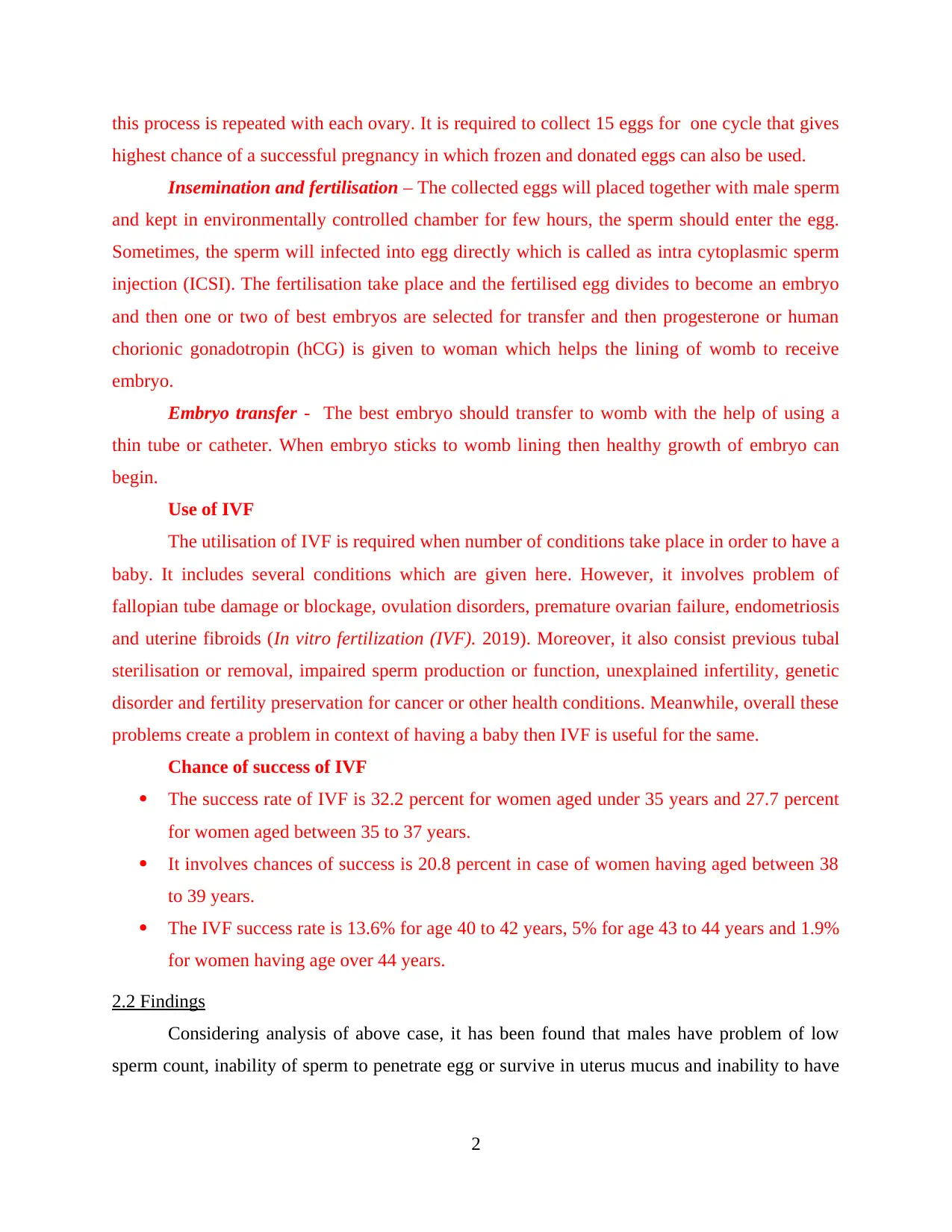
this process is repeated with each ovary. It is required to collect 15 eggs for one cycle that gives
highest chance of a successful pregnancy in which frozen and donated eggs can also be used.
Insemination and fertilisation – The collected eggs will placed together with male sperm
and kept in environmentally controlled chamber for few hours, the sperm should enter the egg.
Sometimes, the sperm will infected into egg directly which is called as intra cytoplasmic sperm
injection (ICSI). The fertilisation take place and the fertilised egg divides to become an embryo
and then one or two of best embryos are selected for transfer and then progesterone or human
chorionic gonadotropin (hCG) is given to woman which helps the lining of womb to receive
embryo.
Embryo transfer - The best embryo should transfer to womb with the help of using a
thin tube or catheter. When embryo sticks to womb lining then healthy growth of embryo can
begin.
Use of IVF
The utilisation of IVF is required when number of conditions take place in order to have a
baby. It includes several conditions which are given here. However, it involves problem of
fallopian tube damage or blockage, ovulation disorders, premature ovarian failure, endometriosis
and uterine fibroids (In vitro fertilization (IVF). 2019). Moreover, it also consist previous tubal
sterilisation or removal, impaired sperm production or function, unexplained infertility, genetic
disorder and fertility preservation for cancer or other health conditions. Meanwhile, overall these
problems create a problem in context of having a baby then IVF is useful for the same.
Chance of success of IVF
The success rate of IVF is 32.2 percent for women aged under 35 years and 27.7 percent
for women aged between 35 to 37 years.
It involves chances of success is 20.8 percent in case of women having aged between 38
to 39 years.
The IVF success rate is 13.6% for age 40 to 42 years, 5% for age 43 to 44 years and 1.9%
for women having age over 44 years.
2.2 Findings
Considering analysis of above case, it has been found that males have problem of low
sperm count, inability of sperm to penetrate egg or survive in uterus mucus and inability to have
2
highest chance of a successful pregnancy in which frozen and donated eggs can also be used.
Insemination and fertilisation – The collected eggs will placed together with male sperm
and kept in environmentally controlled chamber for few hours, the sperm should enter the egg.
Sometimes, the sperm will infected into egg directly which is called as intra cytoplasmic sperm
injection (ICSI). The fertilisation take place and the fertilised egg divides to become an embryo
and then one or two of best embryos are selected for transfer and then progesterone or human
chorionic gonadotropin (hCG) is given to woman which helps the lining of womb to receive
embryo.
Embryo transfer - The best embryo should transfer to womb with the help of using a
thin tube or catheter. When embryo sticks to womb lining then healthy growth of embryo can
begin.
Use of IVF
The utilisation of IVF is required when number of conditions take place in order to have a
baby. It includes several conditions which are given here. However, it involves problem of
fallopian tube damage or blockage, ovulation disorders, premature ovarian failure, endometriosis
and uterine fibroids (In vitro fertilization (IVF). 2019). Moreover, it also consist previous tubal
sterilisation or removal, impaired sperm production or function, unexplained infertility, genetic
disorder and fertility preservation for cancer or other health conditions. Meanwhile, overall these
problems create a problem in context of having a baby then IVF is useful for the same.
Chance of success of IVF
The success rate of IVF is 32.2 percent for women aged under 35 years and 27.7 percent
for women aged between 35 to 37 years.
It involves chances of success is 20.8 percent in case of women having aged between 38
to 39 years.
The IVF success rate is 13.6% for age 40 to 42 years, 5% for age 43 to 44 years and 1.9%
for women having age over 44 years.
2.2 Findings
Considering analysis of above case, it has been found that males have problem of low
sperm count, inability of sperm to penetrate egg or survive in uterus mucus and inability to have
2
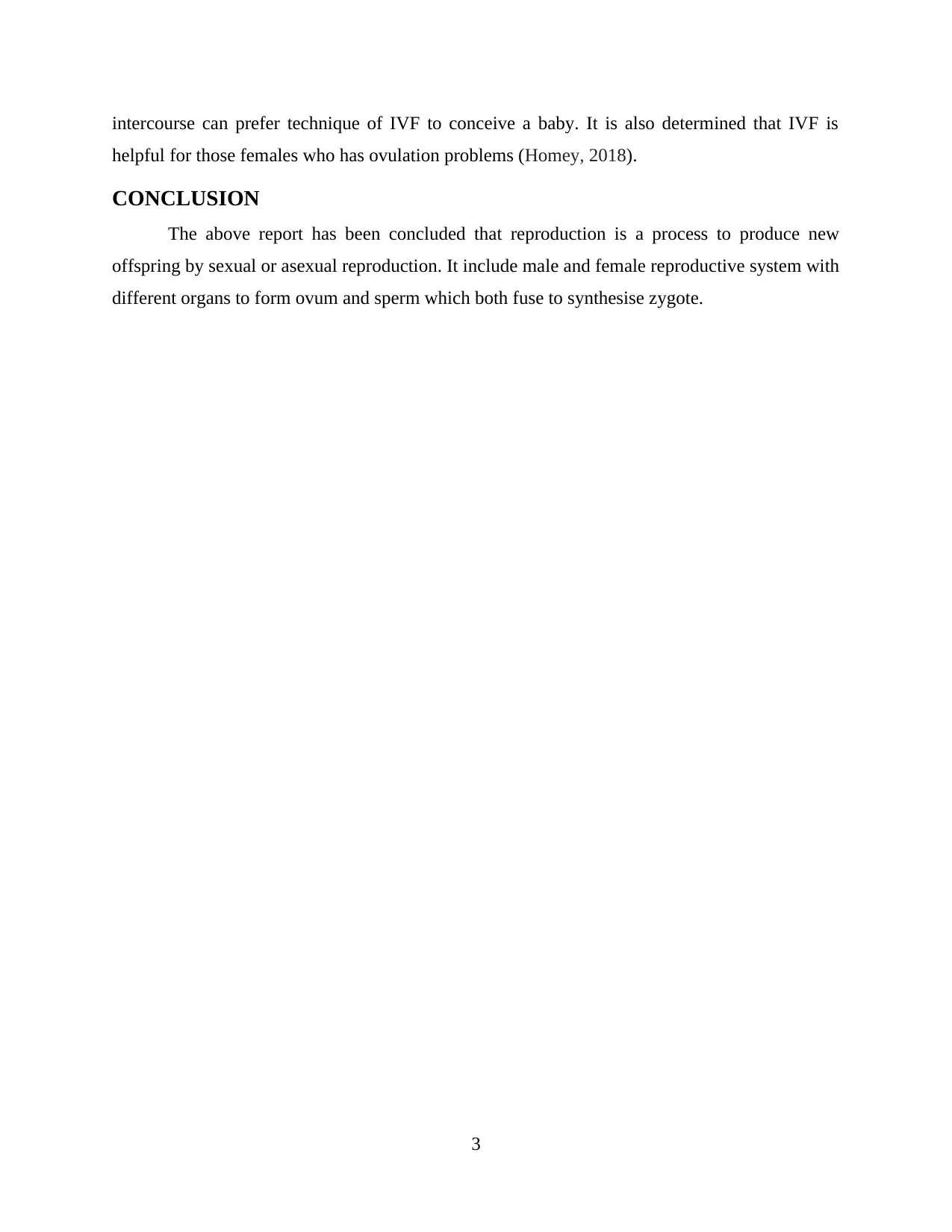
intercourse can prefer technique of IVF to conceive a baby. It is also determined that IVF is
helpful for those females who has ovulation problems (Homey, 2018).
CONCLUSION
The above report has been concluded that reproduction is a process to produce new
offspring by sexual or asexual reproduction. It include male and female reproductive system with
different organs to form ovum and sperm which both fuse to synthesise zygote.
3
helpful for those females who has ovulation problems (Homey, 2018).
CONCLUSION
The above report has been concluded that reproduction is a process to produce new
offspring by sexual or asexual reproduction. It include male and female reproductive system with
different organs to form ovum and sperm which both fuse to synthesise zygote.
3
⊘ This is a preview!⊘
Do you want full access?
Subscribe today to unlock all pages.

Trusted by 1+ million students worldwide
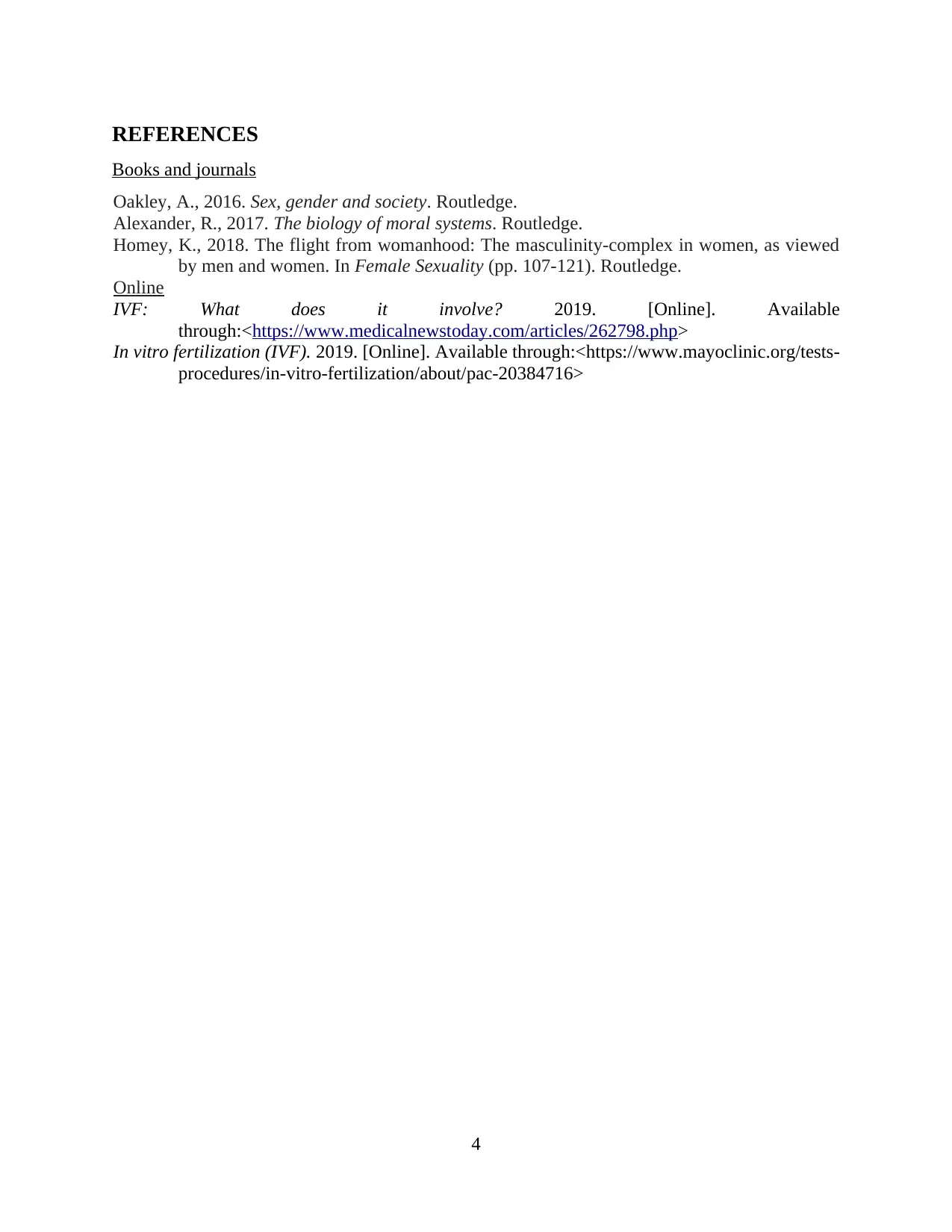
REFERENCES
Books and journals
Oakley, A., 2016. Sex, gender and society. Routledge.
Alexander, R., 2017. The biology of moral systems. Routledge.
Homey, K., 2018. The flight from womanhood: The masculinity-complex in women, as viewed
by men and women. In Female Sexuality (pp. 107-121). Routledge.
Online
IVF: What does it involve? 2019. [Online]. Available
through:<https://www.medicalnewstoday.com/articles/262798.php>
In vitro fertilization (IVF). 2019. [Online]. Available through:<https://www.mayoclinic.org/tests-
procedures/in-vitro-fertilization/about/pac-20384716>
4
Books and journals
Oakley, A., 2016. Sex, gender and society. Routledge.
Alexander, R., 2017. The biology of moral systems. Routledge.
Homey, K., 2018. The flight from womanhood: The masculinity-complex in women, as viewed
by men and women. In Female Sexuality (pp. 107-121). Routledge.
Online
IVF: What does it involve? 2019. [Online]. Available
through:<https://www.medicalnewstoday.com/articles/262798.php>
In vitro fertilization (IVF). 2019. [Online]. Available through:<https://www.mayoclinic.org/tests-
procedures/in-vitro-fertilization/about/pac-20384716>
4
1 out of 7
Related Documents
Your All-in-One AI-Powered Toolkit for Academic Success.
+13062052269
info@desklib.com
Available 24*7 on WhatsApp / Email
![[object Object]](/_next/static/media/star-bottom.7253800d.svg)
Unlock your academic potential
Copyright © 2020–2025 A2Z Services. All Rights Reserved. Developed and managed by ZUCOL.





